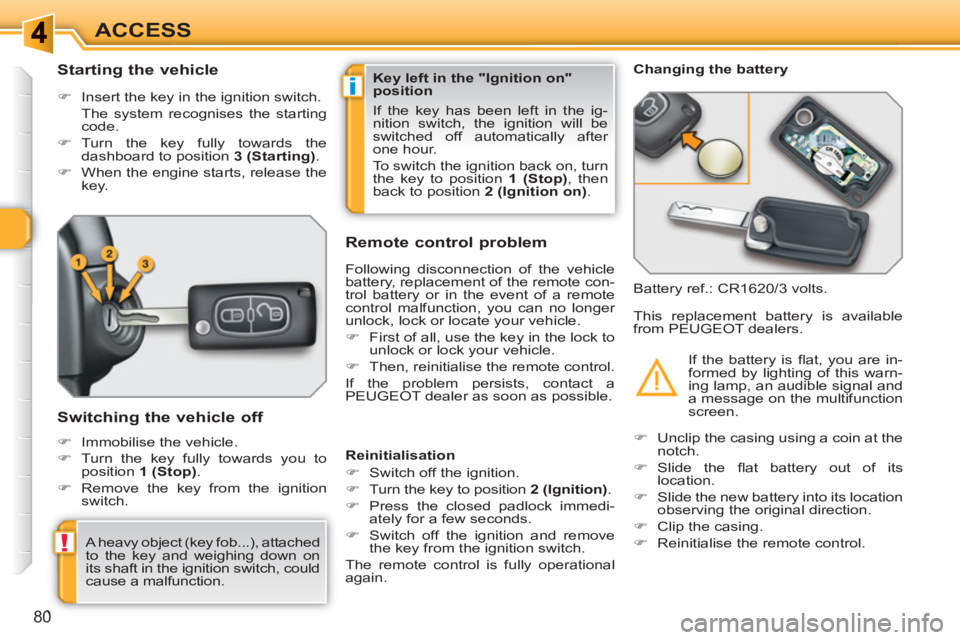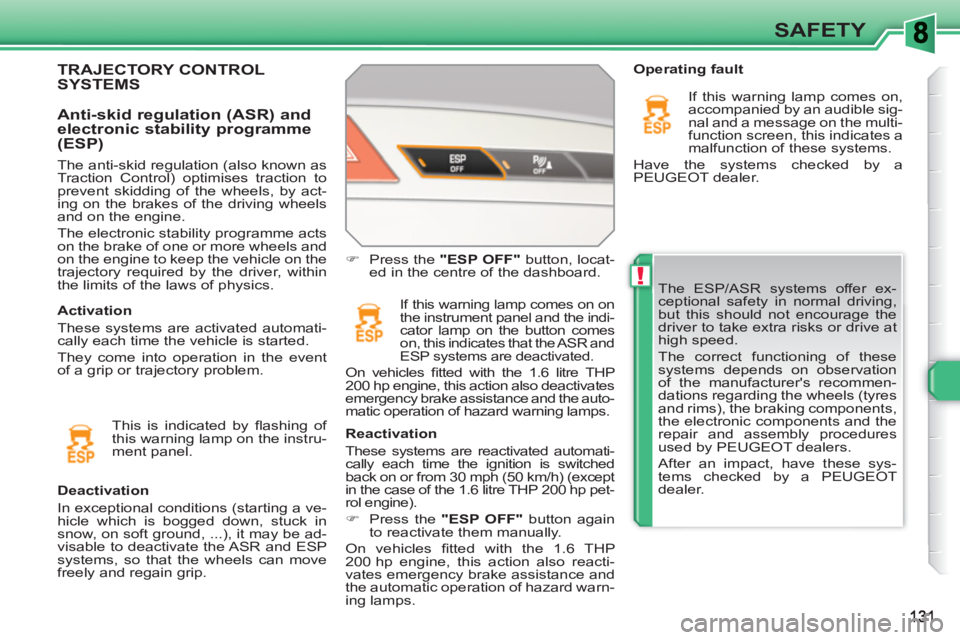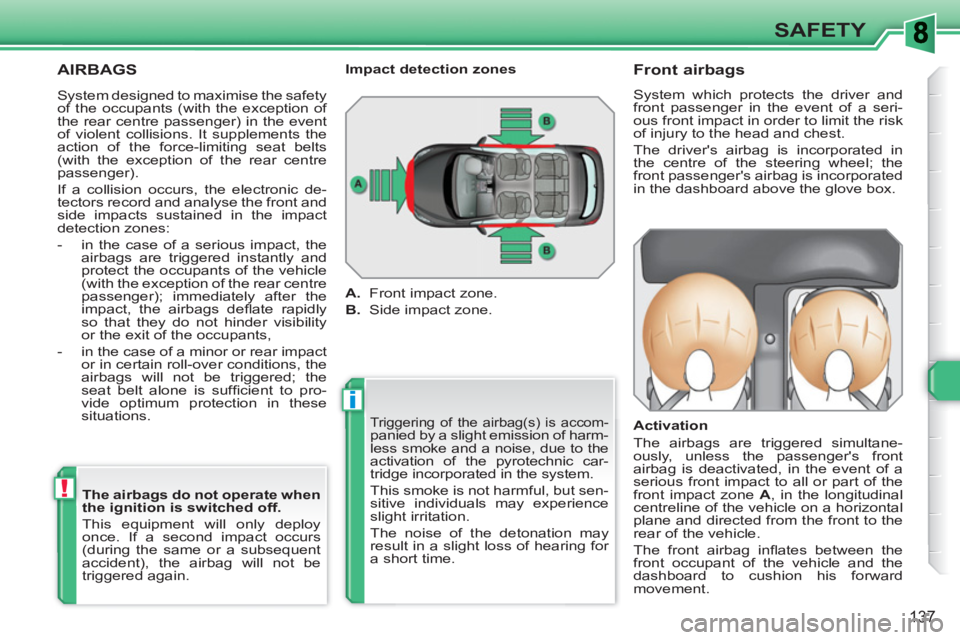2010 PEUGEOT 308 SW BL dashboard
[x] Cancel search: dashboardPage 30 of 336

28
INSTRUMENTS and CONTROLS
Deactivation warning lamps
If one of the following warning lamps
comes on, this confi rms that the corre-
sponding system has been switched off
intentionally.
Passenger's airbag system
deactivation.
The passenger's airbag system
is put into service automatically
when the vehicle is started.
A specifi c control switch, located on the
passenger's side of the dashboard, per-
mits deactivation of the system. This is
confi rmed by continuous lighting of this
warning lamp on the instrument panel
or on the seat belt and passenger's
front airbag warning lamps display.
Dynamic stability control
(ESP/ASR) deactivation
The ESP/ASR system is put
into service automatically when
the vehicle is started.
A specifi c button, located on the dash-
board, permits deactivation of the sys-
tem. This is confi rmed by continuous
lighting of this warning lamp and of the
indicator lamp on the button.
From approximately 30 mph (50 km/h),
the system is reactivated automatically.
Common deactivation warning
lamps
Specifi c deactivation warning lamps
Automatic locking.
If this is displayed, it indicates
that you have deactivated the
automatic locking of the doors
and boot while driving.
Automatic rain sensitive
windscreen wipers.
If this is displayed, it indicates that
you have deactivated automatic
rain sensitive windscreen wipers. The other warning lamps appear on the
large screen, located in the centre of
the instrument panel.
Speed limiter.
If this is displayed, it indicates
that you have deactivated the
speed limiter.
Cruise control.
If this is displayed, it indicates
that you have deactivated the
cruise control.
Automatic illumination of
headlamps.
If this is displayed, it indicates
that you have deactivated auto-
matic illumination of headlamps.
Page 59 of 336

i
i
57
COMFORT
If after an extended stop in sun-
shine, the interior temperature is
very high, fi rst ventilate the pas-
senger compartment for a few mo-
ments.
Put the air fl ow control at a setting
high enough to quickly change the
air in the passenger compartment.
The air conditioning system does
not contain chlorine and does not
present any danger to the ozone
layer.
In order for these systems to be fully effective, follow the operation and main-
tenance guidelines below:
�)
To obtain an even air distribution, take care not to obstruct the exterior air
intake grilles located at the base of the windscreen, the nozzles, the vents
and the air outlets, as well as the air extractor located in the boot.
�)
Do not cover the sunshine sensor, located on the dashboard; this is used
for regulation of the digital air conditioning system.
�)
Operate the air conditioning system for at least 5 to 10 minutes, once or
twice a month to keep it in perfect working order.
�)
Ensure that the passenger compartment fi lter is in good condition and
have the fi lter elements replaced regularly (refer to the "Checks" section).
We recommend the use of a combined passenger compartment fi lter.
Thanks to its special active additive, it contributes to the purifi cation of
the air breathed by the occupants and the cleanliness of the passenger
compartment (reduction of allergic symptoms, bad odours and greasy
deposits).
�)
To ensure correct operation of the air conditioning system, you are also
advised to have it checked regularly as recommended in the Warranty and
Maintenance Record.
�)
If the system does not produce cold air, deactivate it and contact a
PEUGEOT dealer.
When towing the maximum load on a steep gradient in high temperatures,
switching off the air conditioning increases the available engine power and so
improves the towing ability.
The condensation created by the
air conditioning results in a dis-
charge of water under the vehicle
which is perfectly normal.
Page 82 of 336

i
!
80
ACCESS
Starting the vehicle
�)
Insert the key in the ignition switch.
The system recognises the starting
code.
�)
Turn the key fully towards the
dashboard to position 3 (Starting)
.
�)
When the engine starts, release the
key.
Switching the vehicle off
�)
Immobilise the vehicle.
�)
Turn the key fully towards you to
position 1 (Stop)
.
�)
Remove the key from the ignition
switch.
Remote control problem
Following disconnection of the vehicle
battery, replacement of the remote con-
trol battery or in the event of a remote
control malfunction, you can no longer
unlock, lock or locate your vehicle.
�)
First of all, use the key in the lock to
unlock or lock your vehicle.
�)
Then, reinitialise the remote control.
If the problem persists, contact a
PEUGEOT dealer as soon as possible.
Changing the battery
Battery ref.: CR1620/3 volts.
Reinitialisation
�)
Switch off the ignition.
�)
Turn the key to position 2 (Ignition)
.
�)
Press the closed padlock immedi-
ately for a few seconds.
�)
Switch off the ignition and remove
the key from the ignition switch.
The remote control is fully operational
again. If the battery is fl at, you are in-
formed by lighting of this warn-
ing lamp, an audible signal and
a message on the multifunction
screen. This replacement battery is available
from PEUGEOT dealers.
Key left in the "Ignition on"
position
If the key has been left in the ig-
nition switch, the ignition will be
switched off automatically after
one hour.
To switch the ignition back on, turn
the key to position 1 (Stop)
, then
back to position 2 (Ignition
on
)
.
�)
Unclip the casing using a coin at the
notch.
�)
Slide the fl at battery out of its
location.
�)
Slide the new battery into its location
observing the original direction.
�)
Clip the casing.
�)
Reinitialise the remote control.
A heavy object (key fob...), attached
to the key and weighing down on
its shaft in the ignition switch, could
cause a malfunction.
Page 106 of 336

i
104
FITTINGS
ILLUMINATED GLOVE BOX
Its lid has areas for storing a pen, a pair
of spectacles, tokens, cards, a can...
�)
To open the glove box, raise the
handle.
The light comes on when the lid is
opened.
SUN VISOR
Component which protects against sunlight from the front or the side, also equipped
with an illuminated courtesy mirror.
�)
With the ignition on, raise the
concealing fl ap; the mirror is lit
automatically.
This sun visor is also equipped with a
ticket holder.
TOLL CARD/CAR PARK TICKET WINDOWS
Facility for affi xing toll cards and/or car
park tickets.
These windows are located on each
side of the base of the rear view mirror.
They are two non-refl ective areas of the
athermic windscreen.
The athermic windscreen limits
heating of the passenger compart-
ment by reducing the effects of the
sun's rays (ultra-violet). It consists
of a refl ective layer, which also
blocks certain radio-electric signals
(toll card payments, ...). If your vehicle is fi tted with air condition-
ing, the glove box has an air vent A
,
which can be opened or closed. This dis-
tributes the same conditioned air as the
vents in the passenger compartment.
It also gives access to the dashboard
fusebox (refer to the section "Practical
information - § Changing a fuse").
Page 133 of 336

!
SAFETY
The ESP/ASR systems offer ex-
ceptional safety in normal driving,
but this should not encourage the
driver to take extra risks or drive at
high speed.
The correct functioning of these
systems depends on observation
of the manufacturer's recommen-
dations regarding the wheels (tyres
and rims), the braking components,
the electronic components and the
repair and assembly procedures
used by PEUGEOT dealers.
After an impact, have these sys-
tems checked by a PEUGEOT
dealer.
Deactivation
In exceptional conditions (starting a ve-
hicle which is bogged down, stuck in
snow, on soft ground, ...), it may be ad-
visable to deactivate the ASR and ESP
systems, so that the wheels can move
freely and regain grip.
�)
Press the "ESP OFF"
button, locat-
ed in the centre of the dashboard.
If this warning lamp comes on on
the instrument panel and the indi-
cator lamp on the button comes
on, this indicates that the ASR and
ESP systems are deactivated.
On vehicles fi tted with the 1.6 litre THP
200 hp engine, this action also deactivates
emergency brake assistance and the auto-
matic operation of hazard warning lamps.
Reactivation
These systems are reactivated automati-
cally each time the ignition is switched
back on or from 30 mph (50 km/h) (except
in the case of the 1.6 litre THP 200 hp pet-
rol engine).
�)
Press the "ESP OFF"
button again
to reactivate them manually.
On vehicles fi tted with the 1.6 THP
200 hp engine, this action also reacti-
vates emergency brake assistance and
the automatic operation of hazard warn-
ing lamps.
Operating fault
If this warning lamp comes on,
accompanied by an audible sig-
nal and a message on the multi-
function screen, this indicates a
malfunction of these systems.
Have the systems checked by a
PEUGEOT dealer.
TRAJECTORY CONTROLSYSTEMS
Activation
These systems are activated automati-
cally each time the vehicle is started.
They come into operation in the event
of a grip or trajectory problem.
Anti-skid regulation (ASR) and
electronic stability programme
(ESP)
This is indicated by fl ashing of
this warning lamp on the instru-
ment panel.
The anti-skid regulation (also known as
Traction Control) optimises traction to
prevent skidding of the wheels, by act-
ing on the brakes of the driving wheels
and on the engine.
The electronic stability programme acts
on the brake of one or more wheels and
on the engine to keep the vehicle on the
trajectory required by the driver, within
the limits of the laws of physics.
Page 139 of 336

i
!
137
SAFETY
AIRBAGS
Triggering of the airbag(s) is accom-panied by a slight emission of harm-
less smoke and a noise, due to the
activation of the pyrotechnic car-
tridge incorporated in the system.
This smoke is not harmful, but sen-
sitive individuals may experience
slight irritation.
The noise of the detonation may
result in a slight loss of hearing for
a short time.
Front airbags
System which protects the driver and
front passenger in the event of a seri-
ous front impact in order to limit the risk
of injury to the head and chest.
The driver's airbag is incorporated in
the centre of the steering wheel; the
front passenger's airbag is incorporated
in the dashboard above the glove box.
Activation
The airbags are triggered simultane-
ously, unless the passenger's front
airbag is deactivated, in the event of a
serious front impact to all or part of the
front impact zone A
, in the longitudinal
centreline of the vehicle on a horizontal
plane and directed from the front to the
rear of the vehicle.
The front airbag infl ates between the
front occupant of the vehicle and the
dashboard to cushion his forward
movement.
Impact detection zones
A.
Front impact zone.
B.
Side impact zone.
The airbags do not operate when
the ignition is switched off.
This equipment will only deploy
once. If a second impact occurs
(during the same or a subsequent
accident), the airbag will not be
triggered again.
System designed to maximise the safety
of the occupants (with the exception of
the rear centre passenger) in the event
of violent collisions. It supplements the
action of the force-limiting seat belts
(with the exception of the rear centre
passenger).
If a collision occurs, the electronic de-
tectors record and analyse the front and
side impacts sustained in the impact
detection zones:
- in the case of a serious impact, the
airbags are triggered instantly and
protect the occupants of the vehicle
(with the exception of the rear centre
passenger); immediately after the
impact, the airbags defl ate rapidly
so that they do not hinder visibility
or the exit of the occupants,
- in the case of a minor or rear impact
or in certain roll-over conditions, the
airbags will not be triggered; the
seat belt alone is suffi cient to pro-
vide optimum protection in these
situations.
Page 142 of 336

!
140
SAFETY
For the airbags to be fully
effective, observe the following
safety rules:
Sit in a normal upright position.
Wear a correctly adjusted seat belt.
Do not leave anything between the
occupants and the airbags (a child,
pet, object...). This could hamper the
operation of the airbags or injure the
occupants.
Front airbags
Do not drive holding the steering wheel by its spokes or resting your hands on
the centre part of the wheel.
Passengers must not place their feet on the dashboard.
If possible, do not smoke as deployment of the airbags can cause burns or the
risk of injury from a cigarette or pipe.
Never remove or pierce the steering wheel or hit it violently.
*
According to country.
Steering column airbag *
Do not sit with your knees any nearer to the steering wheel than necessary.
Lateral airbags
Use only approved covers on the seats. These will not hinder infl ation of the
lateral airbags. Consult a PEUGEOT dealer.
Do not fi x or attach anything to the seat backs (clothing...). This could cause
injury to the chest or arms if the lateral airbag is triggered.
Do not sit with the upper part of the body any nearer to the door than necessary.
Curtain airbags
Do not fi x or attach anything to the roof. This could cause injury to the head if
the curtain airbag is triggered.
Do not remove the grab handles installed on the roof, they play a part in securing
the curtain airbags.
After an accident or if the vehicle has
been stolen or broken into, have the
airbag systems checked.
All work on the airbag system is strict-
ly forbidden unless it is carried out by
qualifi ed personnel of the PEUGEOT
dealer network.
Even if all of the precautions men-
tioned are observed, a risk of injury
or of minor burns to the head, chest
or arms when an airbag is triggered
cannot be ruled out. The bag infl ates
almost instantly (within a few millisec-
onds) then defl ates within the same
time discharging the hot gas via open-
ings provided for this purpose.
Page 189 of 336

1
187
PRACTICAL INFORMATION
Dashboard fuses
The fusebox is placed in the lower
dashboard, left-hand side, inside the
glove box.
Access to the fuses
�)
refer to the paragraph "Access to
the tools".
Fuse tables
Fuse N°
Rating
Functions
F1
15 A
Rear wiper.
F2
30 A
Locking and deadlocking earth.
F3
5 A
Airbags and pretensioners control unit.
F4
10 A
Clutch pedal and dual-function brake switches,
electrochromatic rear view mirror, air conditioning,
steering wheel angle sensor, automatic gearbox,
switching and protection unit.
F5
30 A
Front one-touch electric windows, folding mirrors
supply, panoramic sunroof blind.
F6
30 A
Rear one-touch electric windows, trailer fusebox.
F7
5 A
Front and rear courtesy lamps, map reading lamps,
rear reading lampd, sun visor illumination, glove
box illumination, torch.
F8
20 A
Audio equipment, audio/telephone, CD changer,
multifunction screen, tyre under-infl ation detection.
F9
30 A
Front 12 V socket.
F10
15 A
Steering mounted controls, alarm siren, alarm
control unit.
F11
15 A
Low current ignition switch.